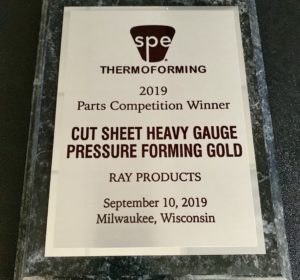We’re thrilled to announce that Ray Products has been awarded the Gold prize at this year’s SPE Thermoforming Conference for our work on the Stratasys F370 Industrial-grade 3-D printer!
The Society of Plastics Engineers (SPE)’s annual thermoforming conference is the leading exposition where thermoformers, suppliers and clients assemble to attend workshops, discussions, and networking sessions on all things thermoforming. One of the most exciting aspects of the conference is its contest, which considers submissions from thermoformers all over the country across several manufacturing categories.
This year, our work on the aforementioned printer – in which we were able to execute some unprecedented thermoforming techniques – won us the Gold in the Cut Sheet/Heavy Gauge category. We’re humbled and honored to have been recognized and want to congratulate everyone who worked on this project and helped to advance the definition of what’s possible in thermoforming.
The Award-Winning Project:
This 3D printer was originally designed for manufacture via reaction injection molding. Noting the constraints of the Reaction Injection Molding (RIM) process, Ray Products worked with the client to convert their design to a 100% molded-in-color pressure-formed unit, which allowed us to significantly reduce the number of parts and tooling required (as well as the total cost of production). Converting to pressure forming also completely eliminated the need for paint and structural ribs that would have limited the printer’s capacity.
This would have been cause for celebration enough, but the real innovation in this unit involved the incorporation of deep undercuts into the thermoformed surface to serve as drawer pulls, a notoriously difficult process to execute effectively. During design review, our own toolmaker even encouraged us to consider a redesign, noting that the undercuts would likely be too large and too deep to pull off. Despite these reservations, we pushed ahead, trusting that our processing capability would deliver the desired results. We are thrilled to report our instincts were correct.
Creating this feature required a two-motion plug assist to generate the double-undercut drawer handle and allow for even, consistent material distribution. Ultimately, we were able to pressure form an undercut with a depth of 2.5”. By incorporating these undercuts into the design, we eliminated the need to attach injection-molded pieces or secondary operations for handle grabs. This significantly reduced the overall manufacturing costs and assembly time of the unit.
We’re very proud of our work on this project and are grateful for SPE’s recognition. Read the pressure forming case study used in this thermoforming project. We’re looking forward to continuing to produce innovative thermoforming solutions and can’t wait to share our next batch of groundbreaking products at next year’s conference. Until then, you know where to find us.

